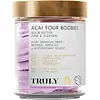What's inside
What's inside
 Key Ingredients
Key Ingredients

 Benefits
Benefits

 Concerns
Concerns

 Ingredients Side-by-side
Ingredients Side-by-side

Butyrospermum Parkii Butter
Skin ConditioningCocos Nucifera Oil
MaskingButter
Skin ConditioningMangifera Indica Seed Oil
EmollientPrunus Amygdalus Dulcis Oil
Skin ConditioningSimmondsia Chinensis Seed Oil
EmollientTheobroma Cacao Seed Butter
EmollientTocopherol
AntioxidantPhospholipids
Skin ConditioningRetinol
Skin ConditioningMelia Azadirachta Flower Extract
Skin ConditioningCoccinia Indica Fruit Extract
Skin ConditioningLeuconostoc/Radish Root Ferment Filtrate
AntimicrobialLonicera Japonica Flower Extract
Skin ConditioningLonicera Caprifolium Flower Extract
PerfumingPopulus Tremuloides Bark Extract
AntiseborrhoeicGluconolactone
Skin ConditioningHydrogenated Soybean Oil
EmollientPhenoxyethanol
PreservativeTetrasodium Glutamate Diacetate
Water
Skin ConditioningEuterpe Oleracea Fruit Extract
Sodium Benzoate
MaskingPotassium Sorbate
PreservativeHylocereus Undatus Fruit Extract
Skin ConditioningPrunus Armeniaca Fruit Extract
Skin ConditioningParfum
MaskingMica
Cosmetic ColorantTitanium Dioxide
Cosmetic ColorantCI 77492
Cosmetic ColorantButyrospermum Parkii Butter, Cocos Nucifera Oil, Butter, Mangifera Indica Seed Oil, Prunus Amygdalus Dulcis Oil, Simmondsia Chinensis Seed Oil, Theobroma Cacao Seed Butter, Tocopherol, Phospholipids, Retinol, Melia Azadirachta Flower Extract, Coccinia Indica Fruit Extract, Leuconostoc/Radish Root Ferment Filtrate, Lonicera Japonica Flower Extract, Lonicera Caprifolium Flower Extract, Populus Tremuloides Bark Extract, Gluconolactone, Hydrogenated Soybean Oil, Phenoxyethanol, Tetrasodium Glutamate Diacetate, Water, Euterpe Oleracea Fruit Extract, Sodium Benzoate, Potassium Sorbate, Hylocereus Undatus Fruit Extract, Prunus Armeniaca Fruit Extract, Parfum, Mica, Titanium Dioxide, CI 77492
Water
Skin ConditioningUrea
BufferingEthoxydiglycol
HumectantGlycolic Acid
BufferingGlycerin
HumectantPEG-40 Hydrogenated Castor Oil
EmulsifyingCocamidopropyl Betaine
CleansingSodium Hydroxide
BufferingPhenoxyethanol
PreservativeAscorbic Acid
AntioxidantPanthenol
Skin ConditioningTocopheryl Acetate
AntioxidantAloe Barbadensis Extract
Skin ConditioningCalendula Officinalis Flower Oil
MaskingCitrus Paradisi Fruit Extract
Skin ConditioningJuniperus Communis Fruit Oil
MaskingLycium Barbarum Fruit Extract
AstringentPunica Granatum Extract
AstringentSodium Chloride
MaskingTetrasodium EDTA
Parfum
MaskingHexyl Cinnamal
PerfumingLimonene
PerfumingLinalool
PerfumingGeraniol
PerfumingHydroxycitronellal
PerfumingSodium Benzoate
MaskingWater, Urea, Ethoxydiglycol, Glycolic Acid, Glycerin, PEG-40 Hydrogenated Castor Oil, Cocamidopropyl Betaine, Sodium Hydroxide, Phenoxyethanol, Ascorbic Acid, Panthenol, Tocopheryl Acetate, Aloe Barbadensis Extract, Calendula Officinalis Flower Oil, Citrus Paradisi Fruit Extract, Juniperus Communis Fruit Oil, Lycium Barbarum Fruit Extract, Punica Granatum Extract, Sodium Chloride, Tetrasodium EDTA, Parfum, Hexyl Cinnamal, Limonene, Linalool, Geraniol, Hydroxycitronellal, Sodium Benzoate
Ingredients Explained
These ingredients are found in both products.
Ingredients higher up in an ingredient list are typically present in a larger amount.
Parfum is a catch-all term for an ingredient or more that is used to give a scent to products.
Also called "fragrance", this ingredient can be a blend of hundreds of chemicals or plant oils. This means every product with "fragrance" or "parfum" in the ingredients list is a different mixture.
For instance, Habanolide is a proprietary trade name for a specific aroma chemical. When used as a fragrance ingredient in cosmetics, most aroma chemicals fall under the broad labeling category of “FRAGRANCE” or “PARFUM” according to EU and US regulations.
The term 'parfum' or 'fragrance' is not regulated in many countries. In many cases, it is up to the brand to define this term.
For instance, many brands choose to label themselves as "fragrance-free" because they are not using synthetic fragrances. However, their products may still contain ingredients such as essential oils that are considered a fragrance by INCI standards.
One example is Calendula flower extract. Calendula is an essential oil that still imparts a scent or 'fragrance'.
Depending on the blend, the ingredients in the mixture can cause allergies and sensitivities on the skin. Some ingredients that are known EU allergens include linalool and citronellol.
Parfum can also be used to mask or cover an unpleasant scent.
The bottom line is: not all fragrances/parfum/ingredients are created equally. If you are worried about fragrances, we recommend taking a closer look at an ingredient. And of course, we always recommend speaking with a professional.
Learn more about ParfumPhenoxyethanol is a preservative that has germicide, antimicrobial, and aromatic properties. Studies show that phenoxyethanol can prevent microbial growth. By itself, it has a scent that is similar to that of a rose.
It's often used in formulations along with Caprylyl Glycol to preserve the shelf life of products.
Sodium Benzoate is a preservative. It's used in both cosmetic and food products to inhibit the growth of mold and bacteria. It is typically produced synthetically.
Both the US FDA and EU Health Committee have approved the use of sodium benzoate. In the US, levels of 0.1% (of the total product) are allowed.
Sodium benzoate works as a preservative by inhibiting the growth of bacteria inside of cells. It prevents the cell from fermenting a type of sugar using an enzyme called phosphofructokinase.
It is the salt of benzoic acid. Foods containing sodium benzoate include soda, salad dressings, condiments, fruit juices, wines, and snack foods.
Studies for using ascorbic acid and sodium benzoate in cosmetics are lacking, especially in skincare routines with multiple steps.
We always recommend speaking with a professional, such as a dermatologist, if you have any concerns.
Learn more about Sodium BenzoateWater. It's the most common cosmetic ingredient of all. You'll usually see it at the top of ingredient lists, meaning that it makes up the largest part of the product.
So why is it so popular? Water most often acts as a solvent - this means that it helps dissolve other ingredients into the formulation.
You'll also recognize water as that liquid we all need to stay alive. If you see this, drink a glass of water. Stay hydrated!
Learn more about Water